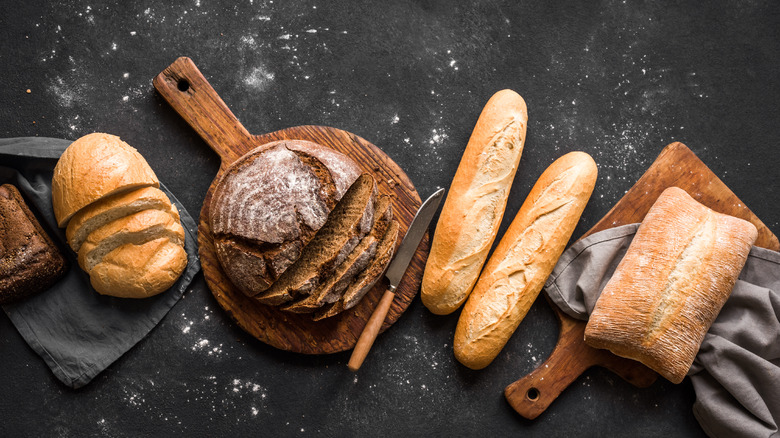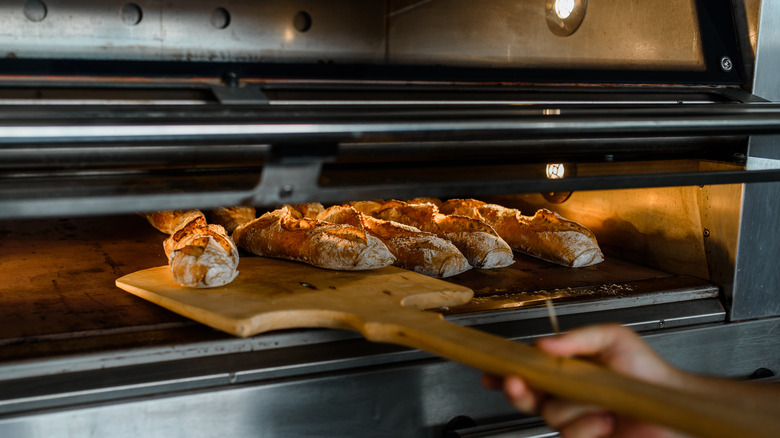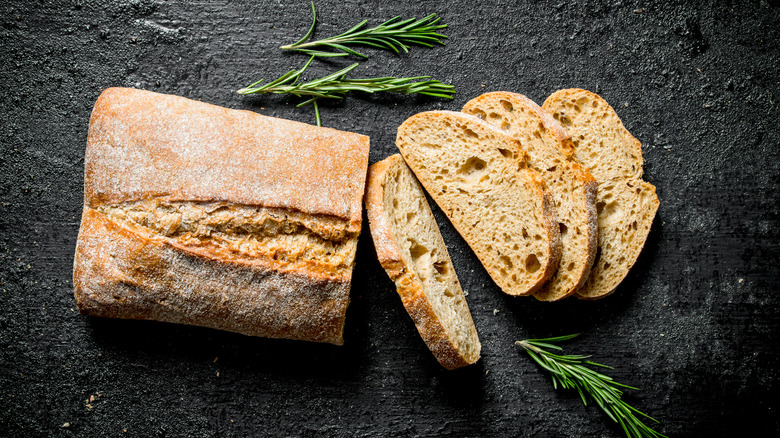The Steamy Difference Between Italian And French Bread
Italian and French bread may not seem all that different, but breads like these from around the world have their own distinct nuances. Once you bite into them, you'll notice that, where Italian bread is a bit more chewy, French bread is a bit crispier. Also, where Italian bread can be slightly dense in texture, French bread is light and airy. And where Italian bread tastes more neutral or savory, French bread tends to be a bit sweeter.
Both loaves are made with similar base ingredients — flour, yeast, water, and salt — so what accounts for these differences in the final product? One of the main factors is the method used to bake them into their individually signature styles, and it comes down to the use of steam.
Italian bread is often baked in a wood fire or stone oven and brushed with an egg wash, which results in its hard, golden crust. But French bread is baked at high temperatures inside a convection oven, using a constant source of steam to develop its signature crunchy crust.
The use of steam in bread baking
You can successfully bake bread using lots of different methods, so what's the purpose of using steam in the process? The main reason is, as the outer crust bakes, it can dry up and harden before the interior has a chance to fully rise and bake to its softest, fluffiest consistency — steam is a way to keep the bread rising and help ensure it bakes more evenly.
Introducing steam into the oven while the bread bakes makes the surface of the loaf a bit more stretchy, allowing it to expand and make room for the rest to rise before it eventually develops that hard, crispy crust that French bread is known for.
There are a few ways to incorporate steam into the baking process. Some professional ovens are made with a steam function that can spray a stream of it throughout the appliance as foods cook or bake. But you can also add your own steam by placing a pan full of water in the bottom of the oven or even a pan of ice cubes for a crispier crust; both options will provide a constant stream of steam as you bake. Or you can simply bake your bread loaf in a preheated Dutch oven, sealing the lid to trap the steam inside.
More differences between Italian and French bread
Italian and French bread differ in more ways than just the use of steam. The first, and often most obvious, are the shapes and sizes of each type of bread. While both come in several different varieties, generally, traditional French bread tends to be shaped into long, thin loaves with slightly rounded edges, while Italian bread is often more circular, oval, or flatter.
French bread is restricted to certain ingredients and amounts of those ingredients — for example, you won't find a French baguette or another classic loaf that uses any fat, unless it's a pastry like croissants or brioche. Italian bread, on the other hand, often contains ingredients outside of flour, water, yeast, and salt, such as small amounts of sugar or fats like olive oil or milk that make for a wetter, denser dough.
And lastly, there tends to be a difference in how the bread is typically consumed. French bread, which is often slightly sweeter in taste, is traditionally paired with sweeter foods; it's often eaten for breakfast and consumed with chocolate and fruity jams. Italian bread is more savory by nature and thus is accompanied with more savory ingredients like olive oil, tomatoes, and cheese.



